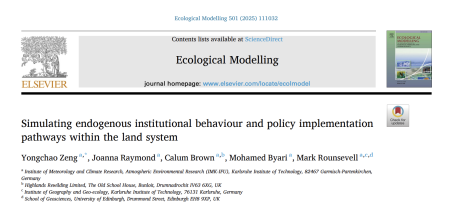
Resource description:
Policy interventions have substantial effects on land use change, providing key levers for multiple objectives, including mitigating climate change and biodiversity loss, and maintaining food security. Policy effects are often complicated, conflicting, and subject to regular change. Despite this, land system models typically treat policies as simple, exogenous modifications to models. To better represent the dynamic nature of policy-making, we develop an endogenous institutional model that can be embedded within land system models, here exemplified by an agent-based model. Numerical experiments are conducted to examine an institution with two policies targeting the production of ecosystem services. We find a clear scope for simulation-based exploration of policy-making, with emergent processes including the marginal diminishing effect of economic policy interventions, asymmetric spill-over effects for different ecosystem services, and trade-offs between policy goals. The endogenous institutional model demonstrates the potential to reveal various emergent patterns with important consequences for land systems.
Highlights
- Novel endogenous institutional model in land systems.
- Model integration with land use agent-based model.
- Marginal diminishing effect of economic policy interventions.
- Asymmetric spill-over effects between ecosystem services.
- Trade-offs between policy goals requiring different policy adaptation frequencies.
Author/Contact:
Yongchao Zeng, Joanna Raymond, Calum Brown , Mohamed Byari, Mark Rounsevell